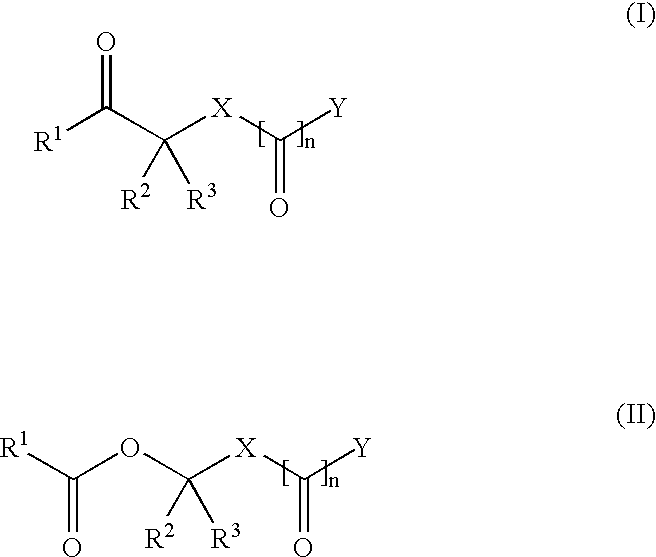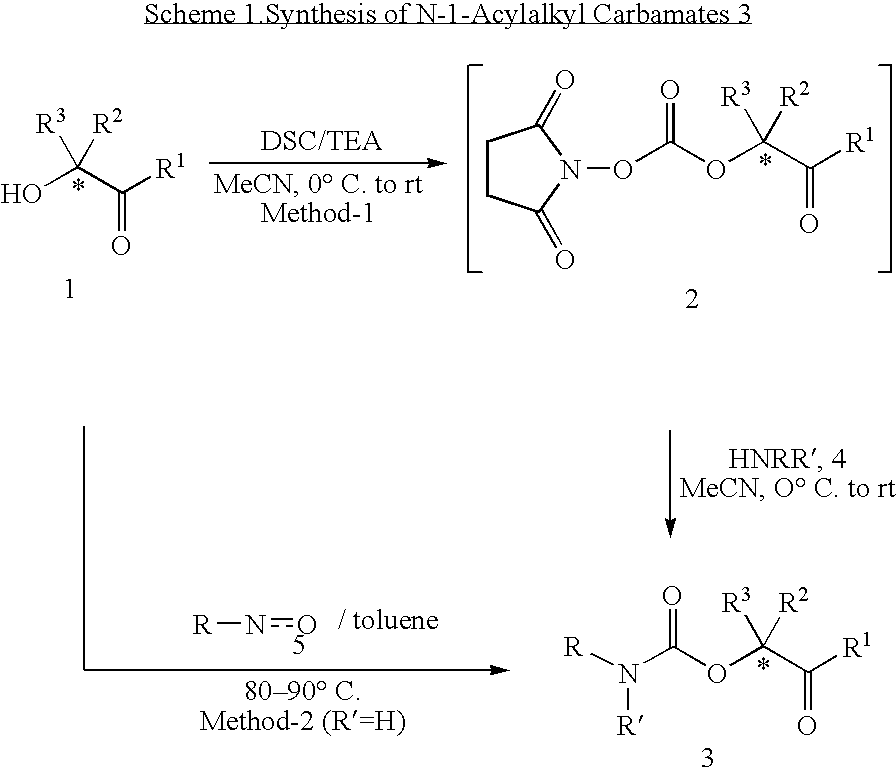Methods for synthesis of acyloxyalkyl compounds
a technology of acyloxyalkyl and acylalkyl derivatives, which is applied in the field of synthesis of acyloxyalkyl derivatives from acylalkyl derivatives by oxidation, can solve the problems of inconvenient manufacturing, lack of stereoselectivity of acyloxyalkyl prodrug synthesis, and insufficient standard oxidant and reaction protocols
- Summary
- Abstract
- Description
- Claims
- Application Information
AI Technical Summary
Problems solved by technology
Method used
Image
Examples
example 1
General Procedure for Synthesis of N-1-Acylalkyl Carbamates (3)
Method 1: To a stirred suspension of the appropriate α-hydroxyketone 1 (10 mmol) and N,N′-disuccinimidyl carbonate (3.2 g, 12.5 mmol) in anhydrous acetonitrile (25 mL) at ice-bath temperature under nitrogen atmosphere was added triethylamine (3 g, 30 mmol). After having stirred at ice-bath temperature for 1 h, the reaction mixture was further stirred at room temperature for 5-8 h (monitored by tlc). Then, a solution of the appropriate amine 4 (15 mmol) in acetonitrile (15 mL) (sodium salts or hydrochloride salts of amino acids were dissolved in 15 mL of a 1:1 mixture of acetonitrile and water) was added dropwise into the reaction mixture at room temperature. The reaction mixture was stirred at room temperature for 12-15 h (monitored by tlc or LC / MS). The reaction mixture was concentrated under reduced pressure at room temperature. The residue was diluted with water (25 mL) and acidified (pH, ˜5-6) with 5% HCl solution....
example 2
General Procedure for Synthesis of 1-Acylalkyl Esters (7)
Method 1: To a stirred solution of 1-(3-dimethylaminopropyl)-3-ethylcarbodiimide hydrochloride (“EDC”) (2.30 g, 12 mmol) in anhydrous dichloromethane (10 mL) at ice-bath temperature under nitrogen atmosphere was added dropwise a solution of the appropriate carboxylic acid 6 (10 mmol) in dichloromethane (5 mL) followed by a solution of triethylamine (1.21 g, 1.2 mmol) in dichloromethane (2 mL). The resulting mixture was stirred at ice-bath temperature for 30 min and then a solution of the appropriate α-hydroxyketone 1 (10 mmol) in dichloromethane (5 mL) was added. After stirring at ice-bath temperature for 1 h the reaction mixture was further stirred at room temperature for 8-12 h (monitored by tlc and / or LC / MS). The reaction mixture was diluted with dichloromethane (25 mL) and washed with water (2×25 mL), dried over Na2SO4 and concentrated in vacuo. The residue was purified by silica gel chromatography using a gradient of 0-...
example 3
General Procedure for Synthesis of O-1-Acylalkyl Carbonates (11)
Method 1: The 1-O-acylalkyl carbonates are prepared according to methods known in the art (Rannard et al., Organic Lett. 1999, 6, 933-936). To a stirred solution of 1,1′-carbonyldiimidazole (CDI) (1.62 g, 10 mmol) in anhydrous toluene (25 mL) under nitrogen atmosphere at room temperature is added the appropriate α-hydroxyketone 1 (15 mmol) followed by potassium hydroxide (5.6 mg, 0.1 mmol). The reaction mixture is stirred at room temperature for 4-12 h (monitored by tlc). Then, alcohol 10 (9 mmol) is added to the reaction mixture. The resulting mixture is heated at 50-60° C. for 4-12 h (monitored by tlc). The reaction mixture is concentrated under reduced pressure. The reaction mixture is dissolved in dichloromethane (25 mL) and washed with water (2×25 mL), dried over Na2SO4 and concentrated in vacuo. The residue is purified by silica gel chromatography using a gradient of ethyl acetate in hexane as eluent to give the...
PUM
| Property | Measurement | Unit |
|---|---|---|
| temperature | aaaaa | aaaaa |
| temperature | aaaaa | aaaaa |
| temperature | aaaaa | aaaaa |
Abstract
Description
Claims
Application Information
 Login to View More
Login to View More - R&D
- Intellectual Property
- Life Sciences
- Materials
- Tech Scout
- Unparalleled Data Quality
- Higher Quality Content
- 60% Fewer Hallucinations
Browse by: Latest US Patents, China's latest patents, Technical Efficacy Thesaurus, Application Domain, Technology Topic, Popular Technical Reports.
© 2025 PatSnap. All rights reserved.Legal|Privacy policy|Modern Slavery Act Transparency Statement|Sitemap|About US| Contact US: help@patsnap.com



